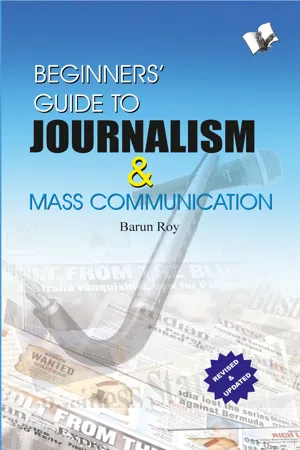
Beginners' Guide To Journalism & Mass Communication
Effective guide to write well, influence people and remain in news
- English
- ePUB (mobile friendly)
- Available on iOS & Android
Beginners' Guide To Journalism & Mass Communication
Effective guide to write well, influence people and remain in news
About This Book
Most books on journalism today are either too complex to comprehend or too superficial. Barun Roy has really done a remarkably good job to fill a long-felt vacuum. This guide introduces basic tools of the applied journalism in simple language. It provides step-by-step instructions to develop skills in the field. Any person interested in journalism, mass communication and in public relations will find this book very interesting, informative and useful. It could even motivate you to contribute articles and features to newspapers and magazines as a freelance writer. Some salient features of the book: *What is journalism? *News Gathering. *News Lead. *Putting the Story together. *Writing in Newspaper Style. *Colourful News Feature. *Headline Story. *Journalism as a Career. #v&spublishers
Frequently asked questions
Information
Frequently Asked Questions
A. Electronic Journalism
1. How is the job market in Electronic Journalism?
2. Where do the ‘Electronic Journalists’ work?
- Commercial TV stations provide the maximum number of jobs. News staffers typically range from 10-20 people in small regional and local channels while national channels have a staff of at least 250-300. A few employ still more.
- Commercial radio stations early in the 21st century were sadly losing newsrooms and jobs to industry consolidation and technology. However, in the last years, the coming up of new FM channels have boosted the audience confidence on the radio and in turn strengthened the field. In our country, most of the villagers still prefer radio, because of its portability and cost. Hence, job opportunities in both the commercial radio stations and public radio stations are immense and increasing rapidly.
- Public television, which in ournation is known as ‘Doordarshan’, offers alternatives to regular commercial fare. Doordarshan also offers solid content in its programmes and has more than 30 regional channels under its aegis which it manages itself, including the now famous Doordarshan offshoots - DD Sports and DD News.
- Public radio stations under the AIR (All India Radio) definitely are the largest employers of radio journalists in the nation.
- Networks, various 24-hour news broadcast multilingual channels, employ several thousand news people.
- Local cable systems in a number of larger cities, maintain news operations with staff to cover ‘hyper-local’ news, which essentially takes place within the communities covered by the local cable station.
- The Web includes sites maintained by most TV and many radio stations. Keeping a site up-to-date is usually the job of a news producer.
- Wire services such as the Press Trust of India, Associated Press and Reuters employ hundreds of journalists to provide news to broadcast stations and newspapers.
- News feed services provides stations with specialised audio and video on news, sports, weather, business, traffic and other audience interest areas.
- Syndication services sell stations news programme inserts on such topics as health, law, personal finances, consumer awareness, sports and entertainment. Like news feed services, they need specialised journalists.
- Corporate television is a growing field utilising specialists trained in news. Its varied projects include the production of videos and programmes for such uses as sales and staff training. Large businesses send programmes they produce to workers on the job within the same buildings or by communication satellite to locations anywhere in the world.
- Public relations help industries, organisations and government tell their stories to the public. PR often seeks employees who are experienced in broadcast news.
3. What are the various opportunities in Electronic Journalism?
4. What are the salaries and emoluments like in this field?
5. What are the pros and cons of Electronic Journalism?
Table of contents
- Cover
- Title Page
- Copyright
- Dedication
- Preface
- Preface
- Contents
- News, Views and You
- Different Kinds of Newspapers
- Different Kinds of Periodicals
- Films, Television and Radio as Instruments of Mass Communication
- Radio in India
- Television in India
- Internet as an Instrument of Mass Communication
- Introduction to Blogging
- Introduction to Freelance Journalism
- Freedom of the Press
- News Gathering
- The News Lead
- Putting the Story Together
- Writing in Newspaper Style
- Covering News
- Colourful News Features
- Describing a Personality
- The Art of Making Columns
- Planning an Editorial Page
- Editorials - Voice of the Newspaper
- Presenting Sports Action
- Copyreading and Proofreading for Accuracy
- Headlining a Story
- Planning Interesting Pages
- Pictures for the Paper
- Advertising
- Frequently Asked Questions
- Journalism as a Career
- Glossary
- Important Newspaper from Around the World
- Bibliography